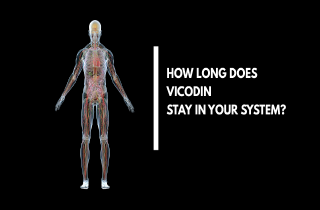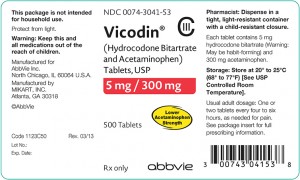ARTICLE OVERVIEW: Vicodin is a short acting opioid analgesic, which means that you can feel the effects of Vicodin quickly (within 30 minutes to 1 hour of taking it) but effects do not last very long. In fact, pain-relieving effects of Vicodin tend to peak at around 2 hours and only last for 4-8 hours. Still, Vicodin can be detected for 2-4 days on most drug tests and up to 3 months or more in hair samples. More here.
Table Of Contents:
- How Do You Take Vicodin?
- Addictive Potential
- Physical Dependence
- Peak Effect and Peak Levels
- Half-Life
- Vicodin Drug Testing
- Problems With Vicodin?
How Do You Take Vicodin?
Vicodin is the brand name combination of hydrocodone and acetaminophen, which is an over-the-counter pain reliever, commonly sold under the brand name Tylenol. Vicodin typically relieves pain for up to six hours, and medical professionals often prescribe this pain reliever for patients after surgery.
Vicodin is mainly administered as a tablet in doses of 5 mg hydrocodone / 500 mg acetaminophen ratios or as a liquid syrup containing 2.5 mg hydrocodone and 167 mg acetaminophen per 5 ml. Doctors usually prescribe and supervise doses of 5 – 10 mg hydrocodone every 4-6 hours. However, dosing varies by doctor and by individual case.
Addictive Potential
Like any opioid pain medication, Vicodin can be both physically and psychologically addictive, and some patients build a tolerance to it. That’s why Vicodin is classified as a Schedule II narcotic by the Controlled Substances Act effective since 1971. It was recently bumped up from a Schedule III drug to Schedule II as a way to stop misuse. [1]
Has it helped?
Dr. Nora Volkow, M.D. presented this testimony to Congress in 2014 to address America’s problem with Vicodin. She stated that the number of prescriptions for opioids increased from around 76 million in 1991 to nearly 207 million in 2013. Further, the United States is the biggest consumer globally of hydrocodone, accounting for almost 100 percent of the world total for medicines like Vicodin. [2] Even more, this 2012 article published in the Journal of Medical Toxicology speaks to the popularity of Vicodin [3]:
At a national level, hydrocodone and oxycodone are the most frequently prescribed opioid analgesics and have the highest level of abuse of any prescription medication.
Just know that Vicodin is extremely addictive! And read the paragraphs at the end of this article to evaluate your risk of a problem.
Physical Dependence
How long it takes to become physically dependent on Vicodin varies with each person. Generally, dependence develops after daily dosing rather quickly: within a few weeks of starting to take Vicodin. When a Vicodin-dependent person stops taking the drug, the body needs time to recover. This causes withdrawal symptoms. Withdrawal from opiates can occur any time long-term use is stopped or cut back.
Early symptoms of withdrawal include:
- Agitation.
- Anxiety.
- Muscle aches.
- Increased tearing.
- Insomnia.
- Runny nose.
- Sweating.
- Yawning.
Late symptoms of withdrawal include:
- Abdominal cramping.
- Diarrhea.
- Dilated pupils.
- Goose bumps.
- Nausea.
- Vomiting.
While these are not signals of addiction in and other themselves…withdrawal can indicate that you may have a harder time getting off Vicodin than you thought.
Peak Effect, Peak Levels, & Half-Life
Peak effect of Vicodin occurs within 30 minutes to 1 hour of taking it orally. In terms of effect, Vicodin is a short acting opioid analgesic, which means that you can feel the effects quickly, but they do not last long. In fact, pain-relieving effects of Vicodin tend to peak at around 2 hours and only last for 4-8 hours. You can compare the peak effect of Vicodin with other common pain medications on this State of Texas opioid comparison chart here. [4]
Peak levels measured in the blood after oral consumption of a single 10-mg dose of hydrocodone in men averaged a concentration of 23.6 ng/mL and occurred after 1.3 hours.
Half-Life
The half-life of a drug is the amount of time it takes for half of the dose to be eliminated from the bloodstream. In medical terms, the half-life is the time it takes for the plasma concentration of a drug to reach half of its original concentration.
On average, most doctors agree that the half-life of Vicodin is 4 hours.
As a result, half-life can influence drug testing and the detection window of opioids like Vicodin. The main factors that affect the half-life of Vicodin include:
Body mass/body fat content: Long-term, heavy use of Vicodin can cause the opioid to be stored in fatty tissue, keeping traces of the drug in the body for even longer periods of time. The more body fat a user has, the more hydrocodone will be absorbed, especially if the liver is already damaged and the body’s metabolism has become compromised.
Diet: Healthy eating and a balanced diet can help you rid Vicodin of your system faster.
Dosage: The amount of Vicodin take will add up. People who use Vicodin sparingly will have a small amount of hydrocodone in their system, while people who use it regularly will have a larger amount for longer periods of time.
Exercise: Exercising or any type of physical activity, boosts your metabolism and cardiovascular system, affecting how long drugs stay in your system.
Hydration: Drinking water can dilute urine, making the concentration of drug molecules lower and harder to detect.
Metabolism: The rate of metabolism varies greatly from person to person. The quicker your metabolism, the faster the drug residue will leave your organisms. Your metabolism is dependent on your age, sex, and other genetic predispositions and environmental factors.
Overall health: If you have liver issues or damage, you can have problems metabolizing Vicodin, which means the drug will stay in your system much longer. You may test positive for weeks after Vicodin intake.
Testing date: The longer you wait to be tested, the lower the chances are Vicodin will show up.
Use of other medications or drugs: The past or present use of other substances can affect how long Vicodin stays in your system. Interactions between different substances can also take place in your body.
Drug Testing For Vicodin
Before you undergo a clinical drug test, your health care provider will usually perform a physical exam and ask questions about your medical history and drug use. The most common drug tests used today require samples of urine, saliva, or hair. The standard opioid assay cutoff level of 300 ng/ml is the concentration cutoff used to define a positive or negative test for Vicodin.
Other medical testing can also follow a Vicodin drug test and will depend on your doctor’s concern about other problems. Many people who use Vicodin can also have other medical problems. Therefore, additional tests may include: blood chemistries and liver function tests such as CHEM-20, CBC (complete blood count, measures red and white blood cells, and platelets, which help blood to clot), chest x-rays, EKG (electrocardiogram, or heart tracing) reading, and/or testing for hepatitis C, HIV, and tuberculosis.
Urine Sample Tests
The most common way to detect Vicodin is via urine sample. It is a painless and simple way to test what is in your system. Vicodin can be detected in the urine 2-4 days after you take it. If you are planning to take a drug test for Vicodin, know that approximation relies on variables such as drug metabolism, your physical condition, fluid intake, as well as the method and frequency of use of Vicodin.
Blood Sample Test
This is not the recommended test to detect Vicodin use.
Saliva Testing
This is the most convenient way to test for immediate Vicodin use. Salvia testing must be done in the days directly after use, preferably between 12 and 36 hours after last use. Before 12 hours, Vicodin will not be detectable, and after 36 hours, traces of Vicodin will be gone.
Hair Sample Test
Testing a hair sample is the most reliable way to test the body for drugs. This is because traces of drugs stay in your hair follicles for up to 90 days after use. However, in the case of detecting the ingredient hydrocodone, it can take 10 days for a hair sample to show the drug. For immediate testing results, salvia and urine are the most appropriate.
Problems With Vicodin?
Vicodin is highly addictive (hydrocodone addictive potential) and is classified as a Schedule III drug by the DEA. But how can you know if you have a problem, or not? You may have a problem with Vicodin if:
- You try quitting but can’t stay quit.
- You crave it.
- You take it, in spite of harm to your health, relationships, work, or finances.
- Vicodin is the most important thing in your life.
See these online drug and alcohol assessment review here to ask yourself questions about possible Vicodin addiction. Always follow up and self-survey with a visit to the doctor’s office. Only a medical professional can diagnose problems with psychoactive drugs. These include certified practitioners like:
- Addiction counselors
- Any medical doctor
- Clinical Social Workers
- Psychiatrists
- Psychologists
Still think you have a problem and don’t know what to do? Reach out for help and call us on the hotline number listed on this page. Or leave us your comments and questions. We respond to every email or question in a comment or video.












Related Posts